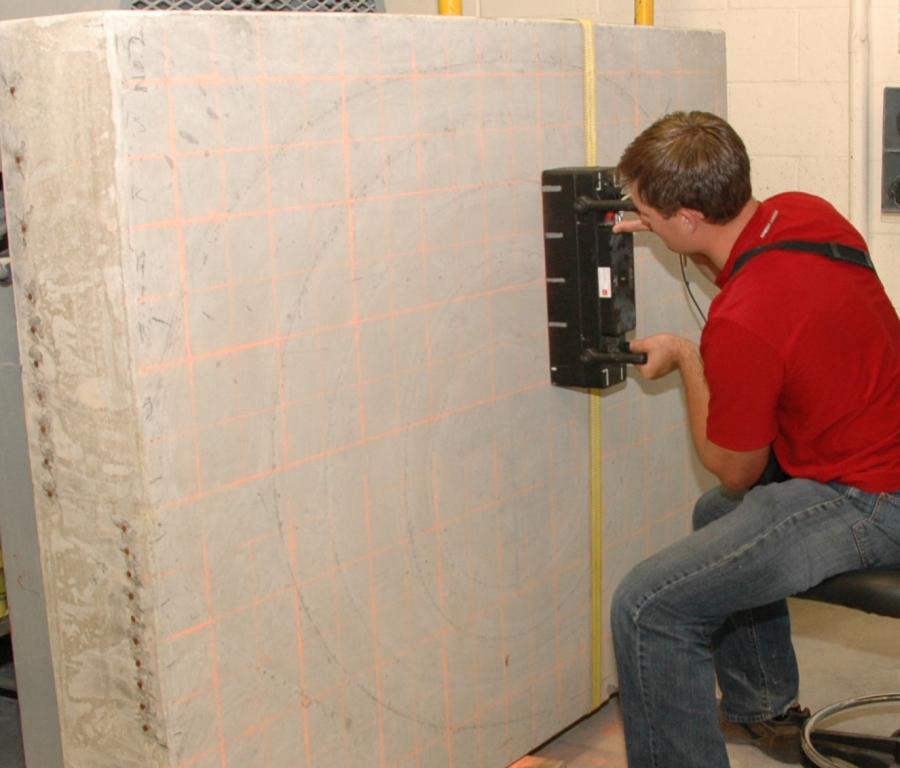
When nuclear power plants in the United States were built, they were licensed for 40 years of operation. Today, most are either approaching that age or have already exceeded it.
“Several years ago, the Nuclear Regulatory Commission began to look at the safety implications of extending these licenses to 60 years,” said Dwight Clayton, an engineer in ORNL’s Electrical and Electronics Systems Research Division. “They determined that, based on the science, extending the licenses from 40 to 60 years wouldn’t be a problem. Then the question came up: Can we go from 60 years to 80 or even 100 years?”
This is where the science becomes less clear. In fact, the Light Water Reactor Sustainability Program in DOE's Office of Nuclear Energy was created to help answer these questions.
At about the 80-year mark, signs of degradation can begin to appear in a nuclear plant's concrete containment structures. To determine whether they are present in a specific structure, however, researchers need an instrument that can peer through as much as a meter of concrete.
“That's where our group comes in,” Clayton said. “Our area of expertise is signal processing and instruments, so we looked at various technologies for evaluating concrete structures and settled on ultrasonic linear arrays. These devices use sound waves to examine the internal condition of concrete structures.”
One challenge for Clayton’s team was adapting commercially available arrays—designed to probe the foot-thick concrete common in buildings and bridge decking—to examine the meter-thick, heavily reinforced concrete common in nuclear power plants.
“The depth of the concrete and the amount of reinforcement make it hard to see through with any type of technology,” Clayton said. "The sound waves produced by the arrays go into the concrete, are reflected off whatever is in the wall, and through concrete return. So they have to travel through as much as 2 meters of concrete.”
That means Clayton’s team had to boost the performance of its off-the-shelf arrays by a factor of three or more. They did this by developing heavy-duty signal-processing software to pull data signals out of the noise created by these obstacles. The additional processing allows them to see defects in the concrete much more clearly.
The team is testing the system on a wall section that simulates a nuclear power plant wall. The mock-up contains various defects, so researchers can see how the system responds to each type of problem area. Delaminations, for instance, are places where the concrete separates. In addition, organic material such as construction debris (leather gloves or pieces of wood) may be inadvertently left in the concrete, where it can lead to corrosion in steel liners.
“We are going to be able to take into account these kinds of construction defects that may not be an issue for 40 years, but as you go beyond 40 or 60 years they start to become an issue,” Clayton said.
Another important way that concrete can deteriorate over time is called alkali silica reaction. ASR is a slow chemical reaction that creates pockets of gel within concrete structures. As these pockets expand, they cause small cracks.
“When you see fine cracks on the side of a concrete bridge, most likely that’s ASR at work,” Clayton said. “It can also be freezing and thawing, but a lot of times it's ASR.”
ORNL is working with the University of Tennessee to build a test wall that develops ASR within months, rather than years, to better understand the mechanisms of ASR and fine tune the ultrasonic linear arrays to detect it.
"By applying elevated temperature and 100 percent humidity to the test wall, we’ll be able to accelerate the process," Clayton said. "We have a two-year project with UT, but these two years of testing will simulate a much longer time in the life of a normal concrete wall.”
This work can be applied to all sorts of concrete structures, including bridges, stadiums and dams.
The team's goal is to provide the NRC and DOE with a concrete structure evaluation system that can be deployed by 2020.
“We will provide a sound, scientific method to see through concrete,” Clayton said. “Whether or not this eventually results in new requirements for nuclear power plants is up to the NRC.”
Editor's note: To read all the stories in the Winter 2017 issue of ORNL Review, visit http://www.ornl.gov/content/ornl-review-v50n1 .

